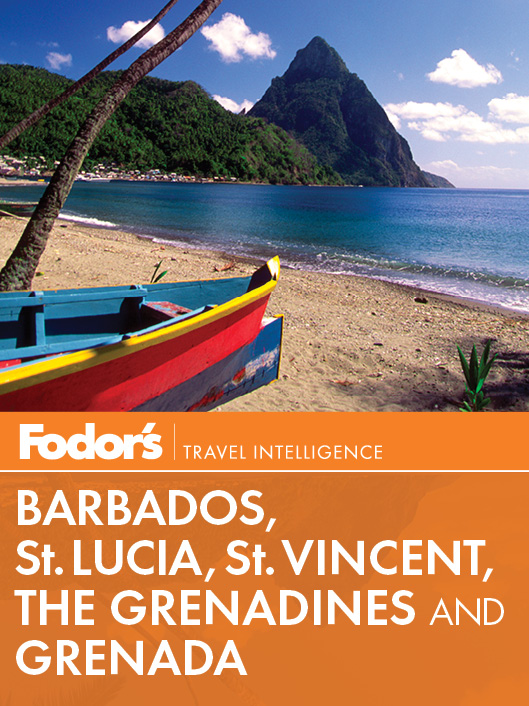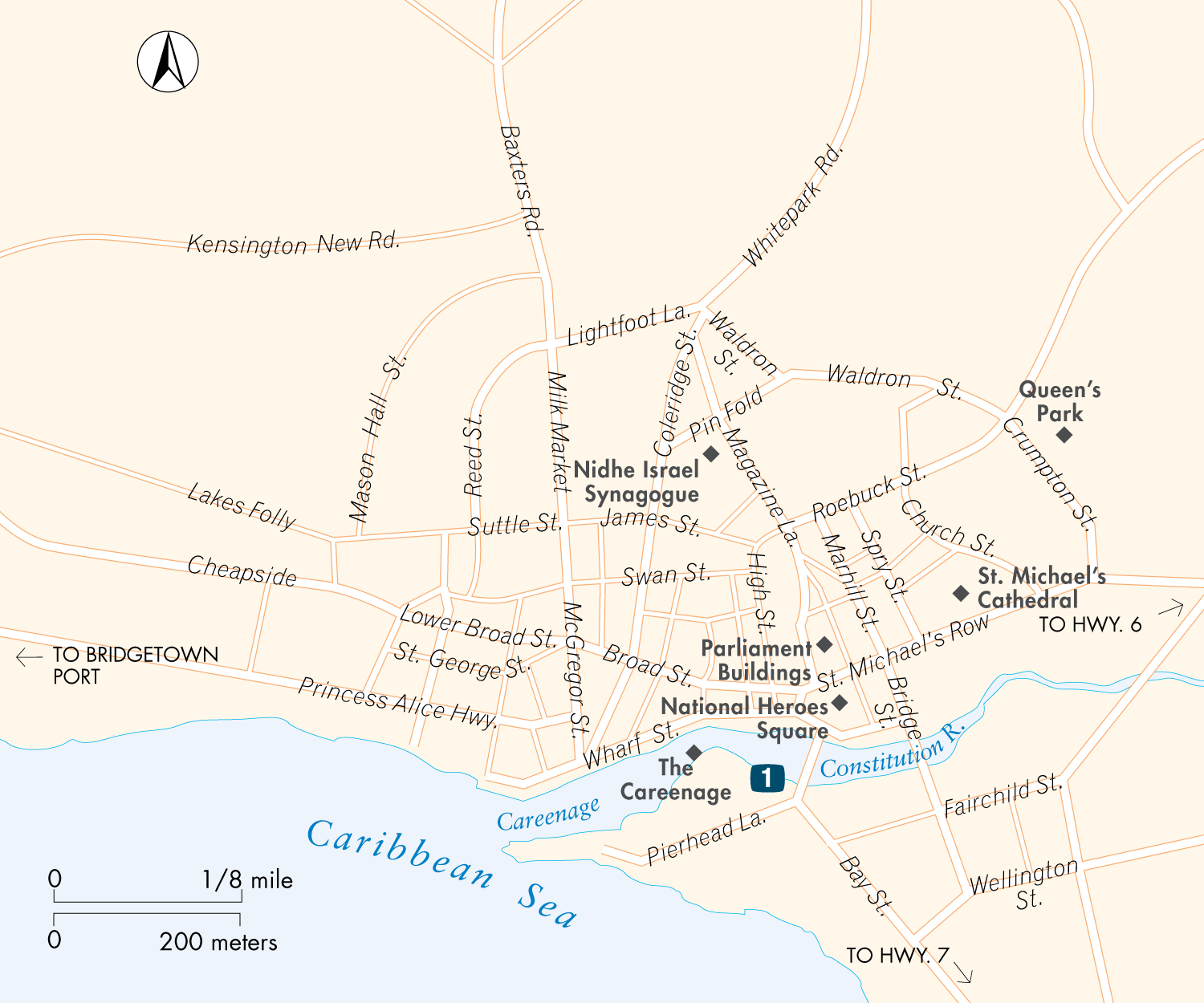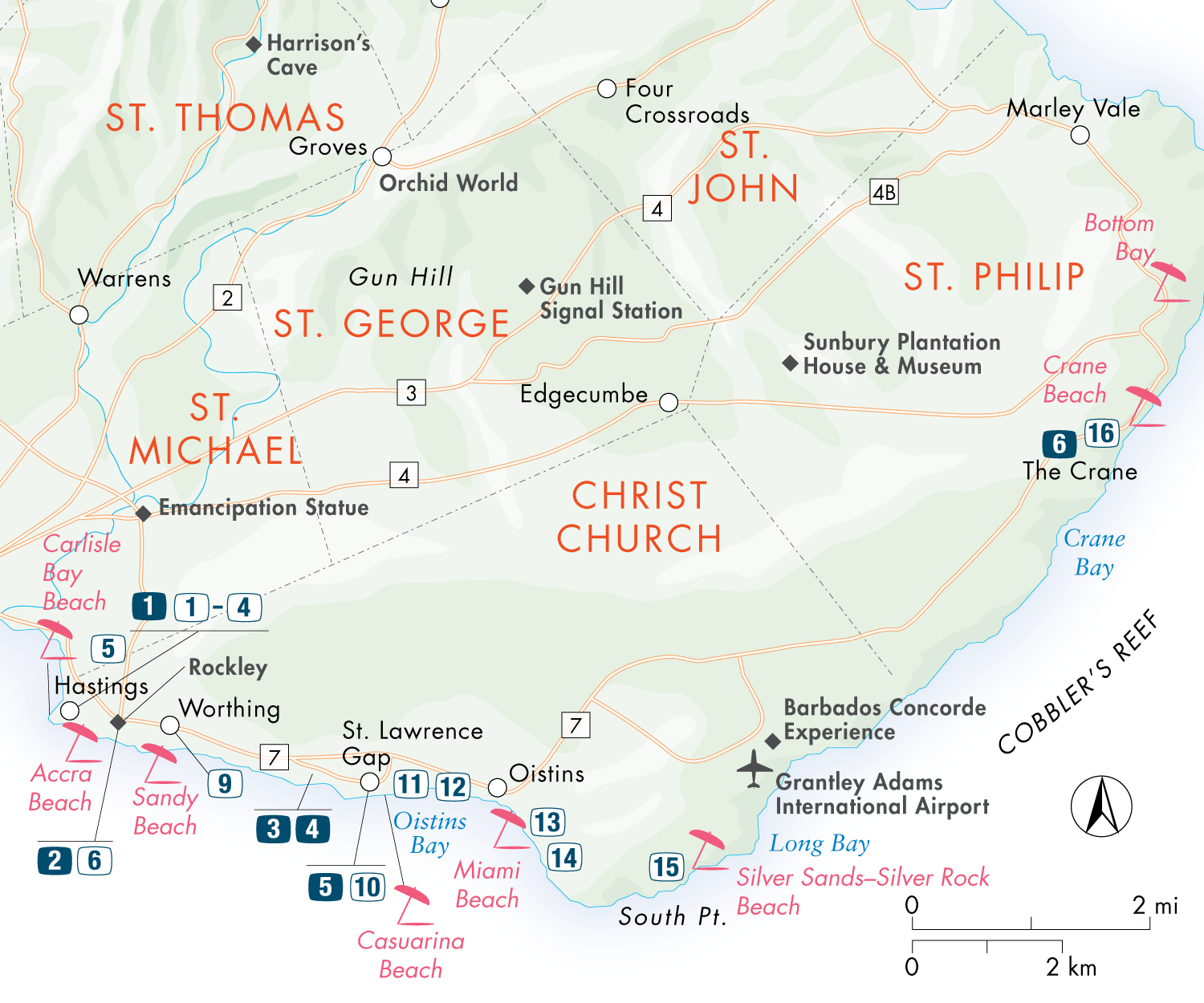WELCOME TO BARBADOS
Barbados stands apart from its neighbors in the Lesser Antilles archipelago, the chain of islands that stretches in a graceful arc from the Virgin Islands to Trinidad. Barbados is isolated in the Atlantic Ocean, 100 mi (160 km) due east of St. Lucia, its nearest neighbor.
Geologically, most of the Lesser Antilles are the peaks of a volcanic mountain range, whereas Barbados is the top of a single, relatively flat protuberance of coral and limestonethe source of building blocks for many a plantation manor. Many of those historic greathouses, in fact, have been carefully restored. Some are open to visitors.
Bridgetown, both capital city and commercial center, is on the southwest coast of pear-shaped Barbados. Most of the 280,000 Bajans (Bajan, pronounced bay -jun, derives from the phonetic British pronunciation of Barbadian) live and work in and around Bridgetown, elsewhere in St. Michael Parish, or along the idyllic west coast or busy south coast. Others reside in tiny villages that dot the interior landscape. Broad sandy beaches, craggy cliffs, and numerous coves make up the coastline, and the interior is consumed by forested hills and gullies and acre upon acre of sugarcane.
Without question, Barbados is the most British island in the Caribbean. In contrast to the turbulent colonial past experienced by neighboring islands, which included repeated conflicts between France and Britain for dominance and control, British rule in Barbados carried on uninterrupted for 340 yearsfrom the first established British settlement in 1627 until independence was granted in 1966. Thats not to say, of course, that there werent significant struggles in Barbados, as elsewhere in the Caribbean, between the British landowners and their African-born slaves and other indentured servants.
With that unfortunate period of slavery relegated to the history books, the British influence on Barbados remains strong today in local manners, attitudes, customs, and politicstempered, of course, by the characteristically warm nature of the Bajan people. In keeping with British-born traditions, many Bajans worship at the Anglican church, afternoon tea is a ritual, cricket is the national pastime (a passion, most admit), dressing for dinner is a firmly entrenched tradition, and patrons at some bars are as likely to order a Pimms Cup or a shandy as a rum and Coke. And yet, Barbados is hardly stuffythis is still the Caribbean, after all.
Tourist facilities are concentrated on the west coast in St. James and St. Peter parishes (appropriately dubbed the Platinum Coast) and on the south coast in Christ Church Parish. Traveling along the west coast to historic Holetown, the site of the first British settlement, and continuing to the northern city of Speightstown, you can find posh beachfront resorts, luxurious private villas, and fine restaurants enveloped by lush gardens and tropical foliage. The trendier, more commercial south coast offers competitively priced hotels and beach resorts, and its St. Lawrence Gap area is jam-packed with shops, restaurants, and nightlife. The relatively wide-open spaces along the southeast coast are proving ripe for development, and some wonderful inns and hotels already take advantage of the intoxicatingly beautiful ocean vistas. For their own vacations, though, Bajans escape to the rugged east coast, where the Atlantic surf pounds the dramatic shoreline with unrelenting force.
All in all, Barbados is a sophisticated tropical island with a rich history, lodgings to suit every taste and pocketbook, and plenty to pique your interest both day and nightwhether youre British or not!
TOP ATTRACTIONS
Great resorts run the gamutfrom unpretentious to knock-your-socks-off.
Golfers can choose among some of the best championship courses in the Caribbean.
Great food includes everything from street-party barbecue to fine dining.
With a wide assortment of land and water sports, sightseeing options, and nightlife, theres always plenty to do.
Bajans are friendly, welcoming, helpful, and hospitable. Youll like them; theyll like you.
GETTING ORIENTED
Barbados stands apart both geographically and geologically from its Caribbean neighbors; its a full 100 mi (161 km) east of the Lesser Antilles chain. The top of a single submerged mountain of coral and limestone, the island is 21 mi (34 km) long, 14 mi (22 km) wide, and relatively flat. The population is about 280,000, and its capital is Bridgetown.
Restaurants
Restaurants
Hotels
Beaches
Restaurants
Hotels
Beaches
Restaurants
Hotels
Beaches
Restaurants
Hotels
BARBADOS PLANNER
LOGISTICS
Getting to Barbados: Several airlines fly nonstop to Barbados, or you may have to connect in Miami or San Juan. Grantley Adams International Airport (BGI) is in Christ Church Parish on the south coast about 15 minutes from hotels situated along the south coast, 45 minutes from the west coast, and 30 minutes from Bridgetown. There is also direct ferry service to Barbados from St. Lucia and St. Vincent.
Hassle Factor: Low.
On the Ground: Ground transportation is available immediately outside the customs area. Airport taxis arent metered, but fares are regulated (about $30 to Speightstown, $20 to $22 to west-coast hotels, $10 to $13 to south-coast hotels). Be sure, however, to establish the fare before getting into the cab and confirm whether the price quoted is in U.S. or Barbadian dollars.
















